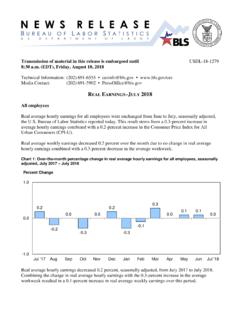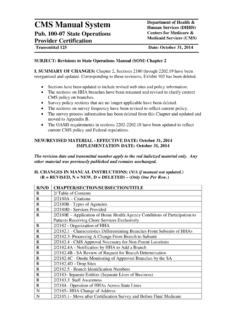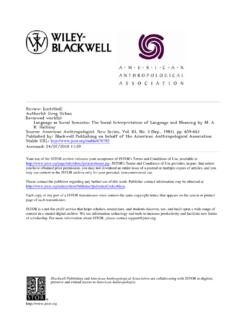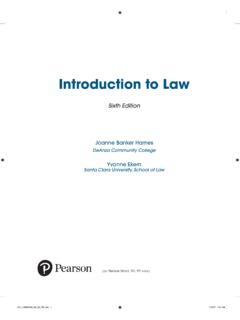Transcription of Fundamentals of Electrical Engineering I
1 Fundamentals of Electrical Engineering IDon H. JohnsonOnline: O N N E X I O N SRice University, Houston, Texas 2016 Don JohnsonThis selection and arrangement of content is licensed under the Creative Commons Attribution License: of Contents1 .. Represent Information .. of Communication Systems .. Fundamental Signal: The Sinusoid .. Problems .. 7 Solutions .. 92 Signals and Numbers .. Signals .. Decomposition .. Signals .. to Systems .. Systems .. and Systems Problems .. 25 Solutions .. 303 Analog Signal , Current, and Generic Circuit Elements .. Circuit Elements.
2 And Real-World Circuit Elements .. Circuits and Interconnection Laws .. Dissipation in Resistor Circuits .. and Parallel Circuits .. Circuits: Resistors and Sources .. with Capacitors and Inductors .. Impedance Concept .. and Frequency Domains .. in the Frequency Domain .. Circuits: Impedances and Sources .. Functions .. Transfer Functions .. Circuit Methods: Node Method .. Conservation in Circuits .. Sources .. Amplifiers .. Diode .. Signal Processing Problems .. 73 Solutions .. 944 Frequency to the Frequency Domain .. Series .. Fourier Series.
3 Signal s Power Spectrum .. Series Approximation of Signals .. Information in the Frequency Domain .. Periodic Signals .. of the Fourier Transform .. Time Invariant Systems .. the Speech Signal .. Domain Problems .. 126 Solutions .. 1395 Digital Signal to Digital Signal Processing .. to Computer Organization .. Sampling Theorem .. Quantization .. Signals and Systems .. Fourier Transform (DTFT) .. Fourier Transforms (DFT) .. : Computational Complexity .. Fourier Transform (FFT) .. Systems .. Systems in the Time-Domain .. Systems in the Frequency Domain.
4 In the Frequency Domain .. of Frequency-Domain Filtering .. Filtering of Analog Signals .. Signal Processing Problems .. 180 Solutions .. 1916 Information Communication .. of Communication Channels .. Channels .. Channels .. Transmission .. Ionosphere and Communications .. with Satellites .. and Interference .. Models .. Communication .. Communication .. Ratio of an Amplitude-Modulated Signal .. Communication .. Phase Shift Keying .. Shift Keying .. Communication Receivers .. Communication in the Presence of Noise .. Communication System Properties.
5 Channels .. Coding Theorem .. and the Huffman Code .. of Coding .. Coding .. Codes .. Channel Coding .. Codes: Hamming Distance .. Codes: Channel Decoding .. Codes: Hamming Codes .. Channel Coding Theorem .. of a Channel .. of Analog and Digital Communication .. Networks .. Routing .. architectures and interconnection .. Protocols .. Communication Problems .. 240 Solutions .. 2557 .. and Combinations .. Allocations .. 263 Solutions .. 265 Index.. 266 Attributions..??6 Chapter Themes1 From its beginnings in the late nineteenth century, Electrical Engineering has blossomed from focusing onelectrical circuits for power, telegraphy and telephony to focusing on a much broader range of , the underlying themes are relevant today:Powercreation and transmission andinformationhave been the underlying themes of Electrical Engineering for a century and a half.
6 This course concentrateson the latter theme: therepresentation, manipulation, transmission, and reception of informationby Electrical means. This course describes what information is, how engineers quantify information, andhow electricalsignalsrepresent can take a variety of forms. When you speak to a friend, your thoughts are translated byyour brain into motor commands that cause various vocal tract components the jaw, the tongue, the lips tomove in a coordinated fashion. Information arises in your thoughts and is represented by speech, which musthave a well defined, broadly known structure so that someone else can understand what you say.
7 Utterancesconvey information in sound pressure waves, which propagate to your friend s ear. There, sound energy isconverted back to neural activity, and, if what you say makes sense, she understands what you say. Yourwords could have been recorded on a compact disc (CD), mailed to your friend and listened to by her on herstereo. Information can take the form of a text file you type into your word processor. You might send thefile via e-mail to a friend, who reads it and understands it. From an information theoretic viewpoint, all ofthese scenarios are equivalent, although the forms of the information representation sound waves, plasticand computer files are very , who don t care about informationcontent, categorize information into two different forms:analoganddigital.
8 Analog information is continuous valued; examples are audio and video. Digitalinformation is discrete valued; examples are text (like what you are reading now) and DNA conversion of information-bearing signals from one energy form into another is known asenergyconversionortransduction. All conversion systems are inefficient since some input energy is lost as heat,but this loss does not necessarily mean that the conveyed information is lost. Conceptually we could use anyform of energy to represent information, but electric signals are uniquely well-suited for information repre-sentation, transmission (signals can be broadcast from antennas or sent through wires), and manipulation(circuits can be built to reduce noise and computers can be used to modify information).
9 Thus, we will beconcerned with how to representall forms of information with Electrical signals, encodeinformation as voltages, currents, and electromagnetic waves, manipulateinformation-bearing electric signals with circuits and computers, and receiveelectric signals and convert the information expressed by electric signals back into a content is available online 1. INTRODUCTIONT elegraphy represents the earliest Electrical information system, and it dates from 1837. At that time, Electrical science was largely empirical, and only those with experience and intuition could develop telegraphsystems.
10 Electrical science came of age when James Clerk Maxwell2proclaimed in 1864 a set of equationsthat he claimed governed all Electrical phenomena. These equations predicted that light was an electro-magnetic wave, and that energy could propagate. Because of the complexity of Maxwell s presentation, thedevelopment of the telephone in 1876 was due largely to empirical work. Once Heinrich Hertz confirmedMaxwell s prediction of what we now call radio waves in about 1882, Maxwell s equations were simplifiedby Oliver Heaviside and others, and were widely read. This understanding of Fundamentals led to a quicksuccession of inventions the wireless telegraph (1899), the vacuum tube (1905), and radio broadcasting thatmarked the true emergence of the communications the first part of the twentieth century, circuit theory and electromagnetic theory were all anelectrical engineer needed to know to be qualified and produce first-rate designs.








